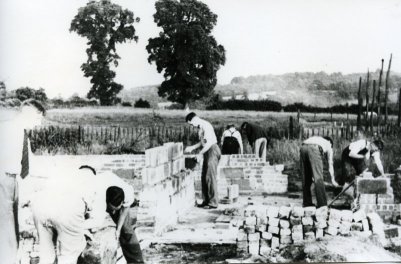History of the Godstone Scout Headquarters 'Endeavour'
The 1st Godstone Scout Group celebrated its 100th Anniversary in 2011, but the Group is actually much older and the magnificent building we now occupy is positively ancient.
1st Godstone Scout Group started on the 16th March 1908 with 11 boys and 2 scouters, but they didn't register with the Scout Association until 1911.
The Group has some photos and documents from 1908 to 1910 in the archives, which indicates that the Scouts were operational in the village at this time.
Their headquarters, ‘The Endeavour’ building, goes even further back in time. The Group originally met in the White Hart Barn in the village. However, the present building was constructed by the Rover Scouts between the years 1937 and 1939, but the materials used came from a much older building, originally a barn in West Sussex going back, we think, as far as the sixteenth century. The result was that the building, even though new at the time, looked like one of Godstone’s oldest structures.
The framework came from this barn, and much of the cladding and fixtures from many Tudor cottages being demolished at the time. Some old timbering has been traced back to an old house where Dick Turpin’s mother was reputed to have lived, the Old Haunted House of Hornchurch, and some say the Ghost came too.....
In the Group’s extensive archives, we have kept all the worksheets kept by the Rover Scouts at the time of construction – they recorded over 3,500 man-hours of work.
The headquarters are entered through a fine old Tudor door into the lobby of the building which is paved with 12th Century Purbeck stones from a church floor in the Avon area, the carvings around the ceiling were done by the boys and the ships bell was presented to the Group by Mr C Nicholson who was the designer of the racing yacht Endeavour.
The crest outside over the main door was unveiled by Lord Baden Powell (son of the founder) and all group members wear this crest on their neckers. It is a Masons mark and was last seen on old London Bridge House, which was destroyed by fire in 1820.
Above the lobby is the minstrel's gallery.
The Troop Room is constructed on the lines of an old Tudor banqueting hall, the timbers on the floor came from the underneath of train carriages, leading off the main hall to what was the scouter's den but is now a fairly up-to-date kitchen. The walls have genuine old Tudor bricks mixed with stones of history. A little piece of Waterloo Bridge, a stone from the Houses of Parliament, stone brought back from the 1937 jamboree in Holland and stone brought back from troop camp sites in Ireland, Stonebarrow Dorset and Mt St Eloi and the Rover Scouts came back with stones from the Mountains of Mourne.
When one considers that this remarkable building was the work of amateurs it was an incredible achievement and the result was, if not, better than if it had been constructed by the professional craftsmen.
A local architect, Mr Williams of Oxted, drew up plans for the building after studying nearly a thousand examples of Tudor craftsman. The Rover Scouts translated those plans into a reality at a recorded cost, would you believe, of £460 – a building that stands to this day and is a pride of the village.
To stimulate enthusiasm the Group prepared a fascinating log as the work progressed, photographs were taken each week showing the Scouts at work and the general growth of the building. These photographs are still held in the archives, and it is still interesting to see how much work and skill was involved in the construction of the building.
The person we have to thank for this fine building is the scout leader at that time in 1937 who was none other than Horace Fairall who founded the present firm of Fairalls, in the village, still going strong today.
After ‘The Endeavour’ was completed the Second World War intervened, during this time the Endeavour was used as a School, but in 1947 a new Headquarters building for the Cub Pack called 'The Bounty' was erected further along the Green in the shape of a Tudor Dovecote. Both buildings stand today as an example of 1st Godstone Scout's fine heritage.
In 2000 the Group improved ‘The Endeavour’ by adding the kitchen and the ladies and gentlemens toilets, and in 2010 an extension was added to the rear of the building to make room for much-needed storage.

